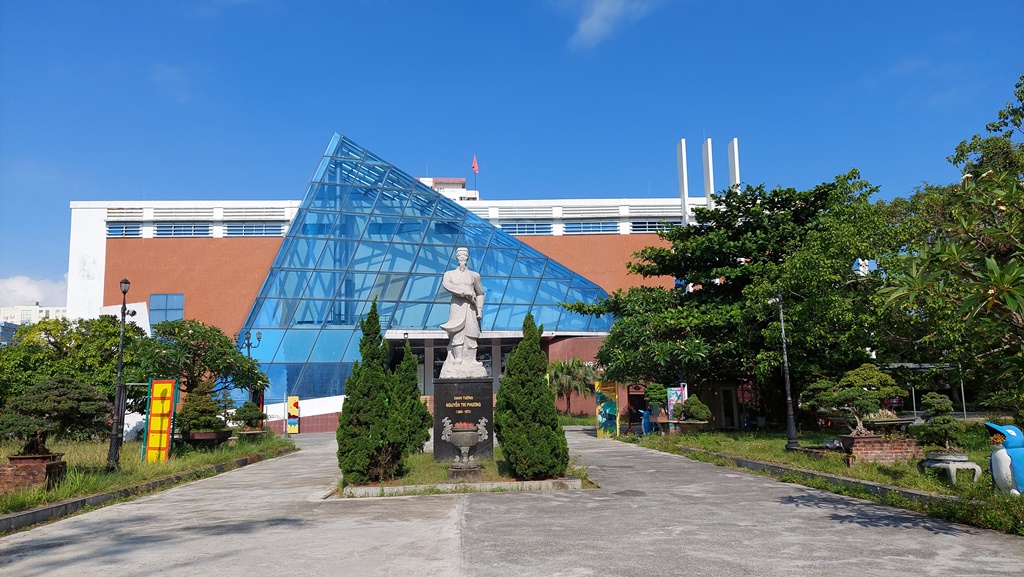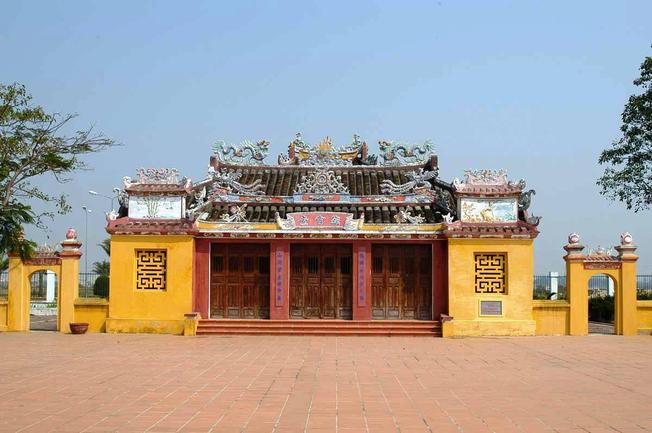Relic point Vietnam
Việt NamDien Hai Citadel relic
Dien Hai Citadel (also known as Dien Hai Fort or Western Fort) is located in the middle of the city center, west of the Han River, in Thach Thang Ward, Hai Chau District, Da Nang City. In the 19th century, Da Nang was the gateway to the imperial city of Hue and the most important port in Central Vietnam. But before that, since the 16th century, Da Nang port had attracted the attention of Western merchant ships, so according to the regulations of the Hue Royal Court, Da Nang port was the only gateway for trade with the outside, as well as for control. Control foreign ships and boats while avoiding foreigners' eyes on the capital. With the important position of the Da Nang trading port, when he first ascended the throne (1802), King Gia Long (Nguyen Dynasty) took care of organizing the guard of this land, building many fortresses on the Son Tra peninsula and along On both sides of the Han River, in addition to Dien Hai and An Hai citadels, there is also Tran Duong That Bao and other strongholds such as My Thi, Hai Chau, Lien Tri, Phuoc Ninh, Hoa Khue... but the most important is Dien Hai Citadel. Dien Hai Citadel is located on the left bank of the Han River, so the French called it Fort de l'Ouest (Western Fortress). It was initially built with land by King Gia Long in 1813, so it was called Bao Dien Hai. It is located near the seaport so it is easily damaged. In 1823, King Minh Mang decreed that it be rebuilt with bricks, so it was called Dien Hai Citadel and retreated further inland, located in the Trem area of Thach Thang village (as at present), to ensure safety and assign Thais. Tuong Nguyen Van Thanh is in charge of construction. The citadel was built in the Vauban style - designed by French engineer Olivier Puymanel (who previously collaborated with Ba Da Loc to help Gia Long). circumference of 556m, trenches more than 3m deep and 2 doors: one door facing East, overlooking the Han River; one door facing south (main door). The citadel has two layers of walls, separated by a deep moat and the outer wall is higher than the inner wall. In the citadel, in addition to the houses of generals and soldiers, there are also gunpowder warehouses, ammunition and weapons warehouses, food warehouses, workshops for casting cannons and repairing broken guns, and a palace palace. During this period, Dien Hai Citadel was one of the most important defensive works in Da Nang along with An Hai station on the left bank of the Han River, controlling ships entering and leaving the Da Nang estuary. After 2004, Da Nang city decided to invest in restoring and renovating Dien Hai Citadel with funds from the City's National Target Program on Culture, with the restoration of the entire citadel wall at the convex corner at Northwest, restore the city walls in the North and East, restore the gate and moat in the South. Besides, it also built the Da Nang Museum on Dien Hai Citadel, rebuilt 172.5 m2 of collapsed citadel walls, and dredged 1,800 m3 of land in filled ditches. During the above construction process, a number of remaining cannons were discovered. In 2010, Da Nang Museum was officially inaugurated and opened to welcome visitors. The Da Nang Museum also displayed cannons found at Citadel of Dien Hai in front of the Museum yard. Over the years, the southern city wall and gate as well as the eastern city wall and part of the northern city wall have been restored. Only the western city wall and moat are adjacent to the residential area so they cannot be repaired. , embellished. Recently, the People's Committee of Da Nang City has issued a policy to relocate households in the west of Dien Hai citadel to return the site to its original state, with a view to restoring, repairing and renovating the entire area. The Dien Hai Citadel relics in the coming years. With the above special values, Dien Hai Citadel Historical Relic was decided by the Prime Minister to rank as a Special National Monument on December 25, 2017. Source: Department of Cultural Heritage
Da Nang 4367 view
Hai Chau Communal House
Hai Chau communal house is considered one of the tourist destinations in Da Nang that is visited by many domestic and foreign tourists every year. Hai Chau communal house is considered the oldest communal house in the coastal city of Da Nang. This relic was officially recognized by the state in 2001. Hai Chau communal house was formerly known as Phuoc Hai pagoda. This is where Lord Nguyen Phuc Chu in the year of the Pig (1719) entered Quang Nam, stopped and stayed here. Hai Chau villagers then built an altar to King Nguyen Phuc Chu here. Hai Chau communal house is located right in the center of Da Nang city on the left bank of the Han River (alley 48 Phan Chau Trinh street, Hai Chau 1 ward, Hai Chau district). According to the genealogy of the Nguyen Van family, one of the 43 clans of Hai Chau village, the ancestors who pioneered and the later generations who cultivated Hai Chau village originated from Hai Chau village, Tinh Gia district, Thanh Hoa province. In the process of following King Le Thanh Tong to explore the land, they established Hai Chau village and settled in this land at the end of the 15th century. Records of the elders show that, in the 5th year of Gia Long (1804), Hai Chau village officials asked King Gia Long to build a communal house to worship the village's Thanh Hoang and the village's predecessors and successors on the land. Nghia Loi on the banks of the Han River. By 1858, the communal house was severely damaged due to the war of invasion by the French colonialists. Two years later, people rebuilt the communal house at the land that is now Da Nang University of Medical Technology and Pharmacy (99 Hung Vuong Street). In 1903, the French occupied the communal house and used it as a place to treat patients during the smallpox epidemic. A year later, the communal house was returned following the villagers' request. However, the people of Hai Chau thought that the village was seriously polluted, so they made a petition to King Thanh Thai asking for permission to rebuild the communal house at the current location (group 3, Hai Chau 1 ward, Hai Chau district). and exists to this day. Hai Chau communal house is one of the national historical and cultural relics in Da Nang, one of the Da Nang attractions that leaves many impressions in the hearts of tourists who come here. The main gate of this village communal house still retains the four words "Hai Chau Chinh Xa", written entirely in Chinese characters. Hai Chau communal house is an architectural complex, located in a campus of up to 3,500 square meters, including: Hai Chau communal house, Tien Hien church, Chu sect church and Ba temple. In front of the village communal house is a small lake with shady rockery and a sapling tree that is hundreds of years old. The church on the left is the church of the Nguyen Van family, the church on the right is a common church including 42 tablets of 42 clans, these 42 clans all come from Thanh Hoa, following King Le Thanh Tong to the South. from the year of the New Mao (1471). King Le Thanh Tong established Han Giang hamlet (now Da Nang) and those clans lived together to become Hai Chau village, which was ordained by the Nguyen Dynasty as "Chinh Commune". Inside the communal house, people keep many lacquered horizontal panels, parallel sentences, and gilded parallel tureens written entirely in Chinese characters and dating back hundreds of years. Among them, there are 9 horizontal panels and 2 pairs of opposing tureens made of wood, all beautifully carved and of high artistic value. On the bell tower of Hai Chau village communal house, there is a bell cast in bronze, on the body of the bell there are sentences and poems written in Chinese characters. These sentences and poems record the heroic historical milestones of the communal house. The general meaning of these words is as follows: In the 5th year of Minh Mang (1842), the pagoda was restored. In 1825, the king issued a decree for the pagoda, naming the pagoda "Phuoc Hai Pagoda", in the 13th year of Minh Mang (1832). ) On auspicious days, Hai Chau Chanh Dong commune created this bell. Source: Da Nang Electronic Newspaper
Da Nang 5868 view
Dai Nam communal house
Dai Nam communal house (local people call it Nai Nam) is a typical cultural and historical relic of Da Nang city. For those who love discovering ancient cultural values, this is a destination not to be missed when coming to the "worth-living city". Dai Nam communal house - a communal house more than 100 years old, associated with many important historical stories and events of the nation. The communal house was built in 1905. In 1999, Dai Nam communal house in Da Nang was recognized as a national monument. The address of this relic is located in Hoa Cuong ward (now Hoa Cuong Bac ward), Hai Chau district, Da Nang city. In 1946, Nai Nam communal house was located in Hoa Binh village (in Nai Nam commune). At that time, Hoa Binh village was the residence of people from Hoa Son and Khue Trung. In 1949, Hoa Binh village merged into Da Nang city and was renamed the South area under this city (separated from Hoa Vang district). The South area includes Nai Nam, Hoa Binh, Khue Trung villages and part of Lien Tri commune. The communal house faces Southeast, built entirely of bricks, tiles and wood, with a roof covered with yin and yang tiles. The communal house has a large yard and surrounding walls. The communal house gate has four square pillars, each pillar is about 5m high. The two central pillars create the main entrance to the communal house, on the top of the pillars are molded two unicorns, the left and right pillars are attached to the wall, the top of the pillars is shaped like a lotus bud. On the middle pillars are pairs of parallel sentences made of porcelain. During the fierce resistance war against the French and the Americans, Dai Nam Communal House in Da Nang was one of the bases and locations of the revolution. The communal house became a base for secret operations. During the period 1960-1965, the communal house was a communication station, communicating in and out of the city. Many important historical events took place here such as the admission ceremony of Party members, the deployment of military and political forces at various times from 1850 - 1975. According to history, many heroes , soldiers lived, fought hard, and died at this location. Source: Da Nang website
Da Nang 6119 view




